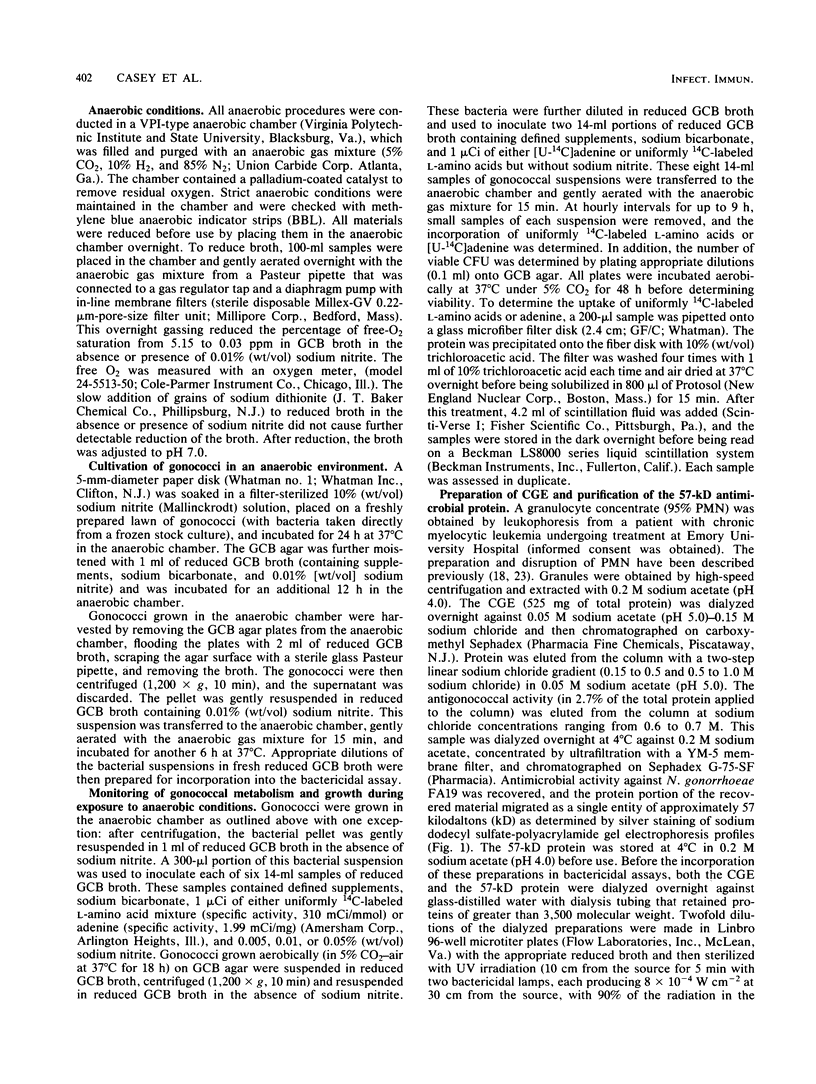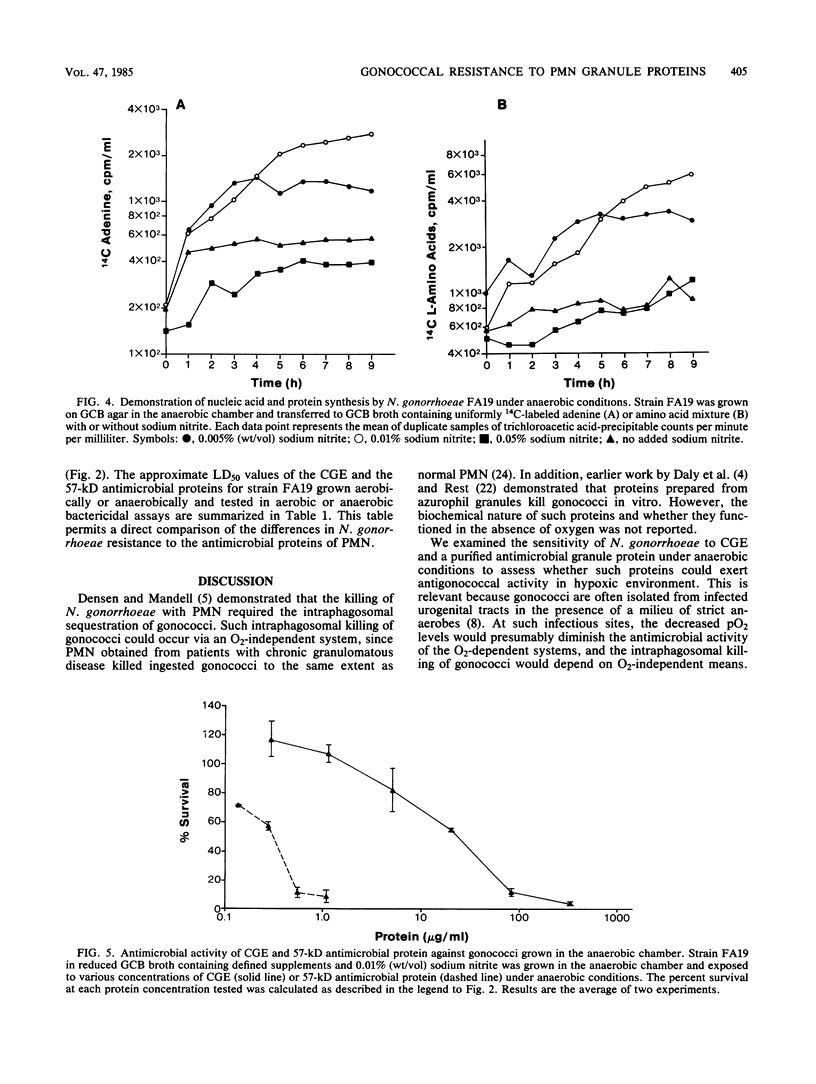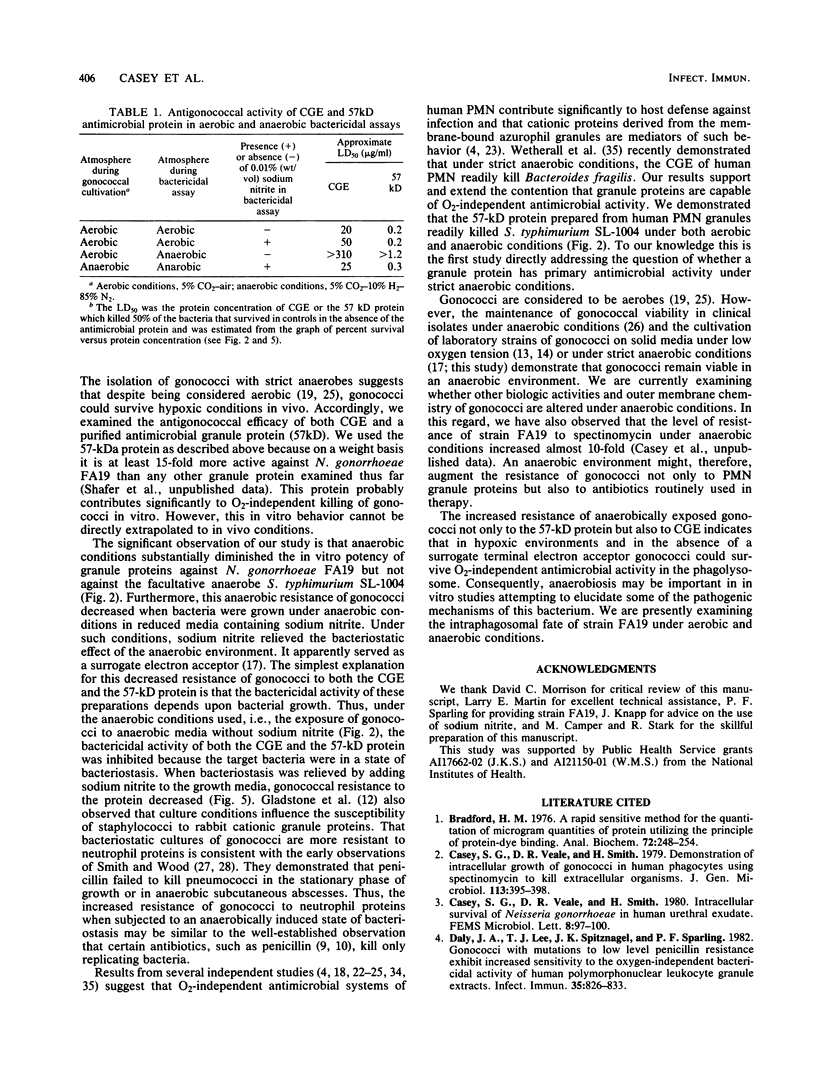Abstract
We investigated the in vitro resistance of Neisseria gonorrhoeae FA19 to the O2-independent antimicrobial systems of human polymorphonuclear leukocytes. Acid extracts of polymorphonuclear leukocyte granules (crude granule extracts) and a purified granule protein (57 kilodaltons) were, at low concentrations, bactericidal for gonococci under aerobic conditions that permitted growth. However, they were less effective under anaerobic conditions that imposed bacteriostasis. We found that adding sodium nitrite to reduced growth media permitted the growth of strain FA19 in an anaerobic environment. Under these conditions with nitrite, anaerobic cultures of strain FA19 were no more resistant to the crude granule extract and the 57-kilodalton protein than aerobic cultures. In contrast, Salmonella typhimurium SL-1004, a facultative anaerobe, was readily killed by both the crude granule extract and the 57-kilodalton antimicrobial protein regardless of the presence or absence of free molecular oxygen. This is the first demonstration that an isolated antimicrobial protein from polymorphonuclear leukocyte granules is active against bacteria under anaerobic conditions. Our results also indicated that the efficacy of human polymorphonuclear leukocyte O2-independent killing of N. gonorrhoeae may, in part, be inhibited by bacteriostatic conditions imposed by hypoxia.
Full text
PDF






Images in this article
Selected References
These references are in PubMed. This may not be the complete list of references from this article.
- Bradford M. M. A rapid and sensitive method for the quantitation of microgram quantities of protein utilizing the principle of protein-dye binding. Anal Biochem. 1976 May 7;72:248–254. doi: 10.1016/0003-2697(76)90527-3. [DOI] [PubMed] [Google Scholar]
- Casey S. G., Veale D. R., Smith H. Demonstration of intracellular growth of gonococci in human phagocytes using spectinomycin to kill extracellular organisms. J Gen Microbiol. 1979 Aug;113(2):395–398. doi: 10.1099/00221287-113-2-395. [DOI] [PubMed] [Google Scholar]
- Daly J. A., Lee T. J., Spitznagel J. K., Sparling P. F. Gonococci with mutations to low-level penicillin resistance exhibit increased sensitivity to the oxygen-independent bactericidal activity of human polymorphonuclear leukocyte granule extracts. Infect Immun. 1982 Mar;35(3):826–833. doi: 10.1128/iai.35.3.826-833.1982. [DOI] [PMC free article] [PubMed] [Google Scholar]
- Densen P., Mandell G. L. Gonococcal interactions with polymorphonuclear neutrophils: importance of the phagosome for bactericidal activity. J Clin Invest. 1978 Dec;62(6):1161–1171. doi: 10.1172/JCI109235. [DOI] [PMC free article] [PubMed] [Google Scholar]
- Dilworth J. A., Hendley J. O., Mandell G. L. Attachment and ingestion of gonococci human neutrophils. Infect Immun. 1975 Mar;11(3):512–516. doi: 10.1128/iai.11.3.512-516.1975. [DOI] [PMC free article] [PubMed] [Google Scholar]
- Fontaine E. A., Taylor-Robinson D., Hanna N. F., Coufalik E. D. Anaerobes in men with urethritis. Br J Vener Dis. 1982 Oct;58(5):321–326. doi: 10.1136/sti.58.5.321. [DOI] [PMC free article] [PubMed] [Google Scholar]
- Frère J. M. Mechanism of action of beta-lactam antibiotics at the molecular level. Biochem Pharmacol. 1977 Dec 1;26(23):2203–2210. doi: 10.1016/0006-2952(77)90280-5. [DOI] [PubMed] [Google Scholar]
- Gibbs D. L., Roberts R. B. The interaction in vitro between human polymorphonuclear leukocytes and Neisseria gonorrhoeae cultivated in the chick embryo. J Exp Med. 1975 Jan 1;141(1):155–171. doi: 10.1084/jem.141.1.155. [DOI] [PMC free article] [PubMed] [Google Scholar]
- Gladstone G. P., Walton E., Kay U. The effect of cultural conditions on the susceptibility of staphylococci to killing by the cationic proteins from rabbit polymorphonuclear leucocytes. Br J Exp Pathol. 1974 Oct;55(5):427–447. [PMC free article] [PubMed] [Google Scholar]
- James-Holmquest A. N., Wende R. D., Mudd R. L., Williams R. P. Comparison of atmospheric conditions for culture of clinical specimens of Neisseria gonorrhoeae. Appl Microbiol. 1973 Oct;26(4):466–469. doi: 10.1128/am.26.4.466-469.1973. [DOI] [PMC free article] [PubMed] [Google Scholar]
- Kellogg D. S., Crawford J. A., Callaway C. S. Cultivation of Neisseria gonorrhoeae under low-oxygen conditions. J Clin Microbiol. 1983 Jul;18(1):178–184. doi: 10.1128/jcm.18.1.178-184.1983. [DOI] [PMC free article] [PubMed] [Google Scholar]
- Klebanoff S. J. Antimicrobial mechanisms in neutrophilic polymorphonuclear leukocytes. Semin Hematol. 1975 Apr;12(2):117–142. [PubMed] [Google Scholar]
- Knapp J. S., Clark V. L. Anaerobic growth of Neisseria gonorrhoeae coupled to nitrite reduction. Infect Immun. 1984 Oct;46(1):176–181. doi: 10.1128/iai.46.1.176-181.1984. [DOI] [PMC free article] [PubMed] [Google Scholar]
- Modrzakowski M. C., Spitznagel J. K. Bactericidal activity of fractionated granule contents from human polymorphonuclear leukocytes: antagonism of granule cationic proteins by lipopolysaccharide. Infect Immun. 1979 Aug;25(2):597–602. doi: 10.1128/iai.25.2.597-602.1979. [DOI] [PMC free article] [PubMed] [Google Scholar]
- Ofek I., Beachey E. H., Bisno A. L. Resistance of Neisseria gonorrhoeae to phagocytosis: relationship to colonial morphology and surface pili. J Infect Dis. 1974 Mar;129(3):310–316. doi: 10.1093/infdis/129.3.310. [DOI] [PubMed] [Google Scholar]
- Punsalang A. P., Jr, Sawyer W. D. Role of pili in the virulence of Neisseria gonorrhoeae. Infect Immun. 1973 Aug;8(2):255–263. doi: 10.1128/iai.8.2.255-263.1973. [DOI] [PMC free article] [PubMed] [Google Scholar]
- Rest R. F., Cooney M. H., Spitznagel J. K. Susceptibility of lipopolysaccharide mutants to the bactericidal action of human neutrophil lysosomal fractions. Infect Immun. 1977 Apr;16(1):145–151. doi: 10.1128/iai.16.1.145-151.1977. [DOI] [PMC free article] [PubMed] [Google Scholar]
- Rest R. F., Fischer S. H., Ingham Z. Z., Jones J. F. Interactions of Neisseria gonorrhoeae with human neutrophils: effects of serum and gonococcal opacity on phagocyte killing and chemiluminescence. Infect Immun. 1982 May;36(2):737–744. doi: 10.1128/iai.36.2.737-744.1982. [DOI] [PMC free article] [PubMed] [Google Scholar]
- Rest R. F. Killing of Neisseria gonorrhoeae by human polymorphonuclear neutrophil granule extracts. Infect Immun. 1979 Aug;25(2):574–579. doi: 10.1128/iai.25.2.574-579.1979. [DOI] [PMC free article] [PubMed] [Google Scholar]
- SMITH M. R., WOOD W. B., Jr An experimental analysis of the curative action of penicillin in acute bacterial infections. III. The effect of suppuration upon the antibacterial action of the drug. J Exp Med. 1956 Apr 1;103(4):509–522. doi: 10.1084/jem.103.4.509. [DOI] [PMC free article] [PubMed] [Google Scholar]
- Short H. B., Clark V. L., Kellogg D. S., Jr, Young F. E. Anaerobic survival of clinical isolates and laboratory strains of Neisseria gonorrhoea: use in transfer and storage. J Clin Microbiol. 1982 May;15(5):915–919. doi: 10.1128/jcm.15.5.915-919.1982. [DOI] [PMC free article] [PubMed] [Google Scholar]
- Swanson J., Kraus S. J., Gotschlich E. C. Studies on gonococcus infection. I. Pili and zones of adhesion: their relation to gonococcal growth patterns. J Exp Med. 1971 Oct 1;134(4):886–906. doi: 10.1084/jem.134.4.886. [DOI] [PMC free article] [PubMed] [Google Scholar]
- Swanson J., Sparks E., Zeligs B., Siam M. A., Parrott C. Studies on gonococcus infection. V. Observations on in vitro interactions of gonococci and human neutrophils. Infect Immun. 1974 Sep;10(3):633–644. doi: 10.1128/iai.10.3.633-644.1974. [DOI] [PMC free article] [PubMed] [Google Scholar]
- Thongthai C., Sawyer W. D. Studies on the virulence of Neisseria gonorrhoeae. I. Relation of colonial morphology and resistance to phagocytosis by polymorphonuclear leukocytes. Infect Immun. 1973 Mar;7(3):373–379. doi: 10.1128/iai.7.3.373-379.1973. [DOI] [PMC free article] [PubMed] [Google Scholar]
- Veale D. R., Goldner M., Penn C. W., Ward J., Smith H. The intracellular survival and growth of gonococci in human phagocytes. J Gen Microbiol. 1979 Aug;113(2):383–393. doi: 10.1099/00221287-113-2-383. [DOI] [PubMed] [Google Scholar]
- WOOD W. B., Jr, SMITH M. R. An experimental analysis of the curative action of penicillin in acute bacterial infections. I. The relationship of bacterial growth rates to the antimicrobial effect of penicillin. J Exp Med. 1956 Apr 1;103(4):487–498. doi: 10.1084/jem.103.4.487. [DOI] [PMC free article] [PubMed] [Google Scholar]
- Watt P. J. The fate of gonococci in polymorphonuclear leucocytes. J Med Microbiol. 1970 Aug;3(3):501–509. doi: 10.1099/00222615-3-3-501. [DOI] [PubMed] [Google Scholar]
- Weiss J., Victor M., Stendhal O., Elsbach P. Killing of gram-negative bacteria by polymorphonuclear leukocytes: role of an O2-independent bactericidal system. J Clin Invest. 1982 Apr;69(4):959–970. doi: 10.1172/JCI110535. [DOI] [PMC free article] [PubMed] [Google Scholar]
- Wetherall B. L., Pruul H., McDonald P. J. Oxygen-independent killing of Bacteroides fragilis by granule extracts from human polymorphonuclear leukocytes. Infect Immun. 1984 Mar;43(3):1080–1084. doi: 10.1128/iai.43.3.1080-1084.1984. [DOI] [PMC free article] [PubMed] [Google Scholar]
- Witt K., Veale D. R., Finch H., Penn C. W., Sen D., Smith H. Resistance of Neisseria gonorrhoeae grown in vivo to ingestion and digestion by phagocytes of human blood. J Gen Microbiol. 1976 Oct;96(2):341–350. doi: 10.1099/00221287-96-2-341. [DOI] [PubMed] [Google Scholar]
- Witt K., Veale D. R., Smith H. Resistance of Neisseria gonorrhoeae to ingestion and digestion by phagocytes of human buffy coat. J Med Microbiol. 1976 Feb;9(1):1–12. doi: 10.1099/00222615-9-1-1. [DOI] [PubMed] [Google Scholar]




